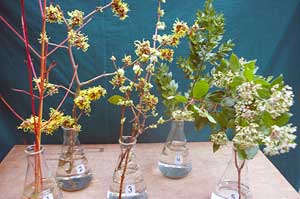January Color Appears at the Washington Park Arboretum (Part II)
Witt Winter Garden

1) Cornus sanguinea ‘Midwinter Fire’ Bloodtwig Dogwood
- Young stems of this cultivar are orange-yellow with the sunny side turning carmine red.
- Stem color of species is gray to purple, while the color of C.s. ‘Midwinter Fire’ is yellow-green in summer changing to winter colors rapidly at leaf drop in fall.
2) Hamamelis x intermedia ‘Pallida’ Witch Hazel
- This hybrid of H. japonica and H. mollis was selected for its pale sulfur-yellow flowers which tend to glow in the low light levels of morning and evening.
- Cultivars of witch hazel can have flower colors from pale yellow to deep red, some being quite fragrant while others are much less so.
3) Lonicera standishii Honeysuckle
- This semi-evergreen shrub bears fragrant flowers from early winter to early spring.
- Lonicera standishii is native to China.
4) Ruscus aculeatus Butcher’s Broom
- Lacking true leaves, what you are seeing are called “cladophylls” which are simply flattened stems.
- The flowers of this plant are dioecious, only 2 mm across and are located in the center of the cladophylls.
- Butcher’s Broom is native to Europe, Turkey, North Africa and the Azores.
5) Viburnum tinus ‘Pink Prelude’ Laurustinus
- This species has been cultivated in England since the 16th century.
- V.t. ‘Pink Prelude’ has white flowers that age to pink.
- The flowers of laurustinus are followed by small, but showy metallic-blue fruit.